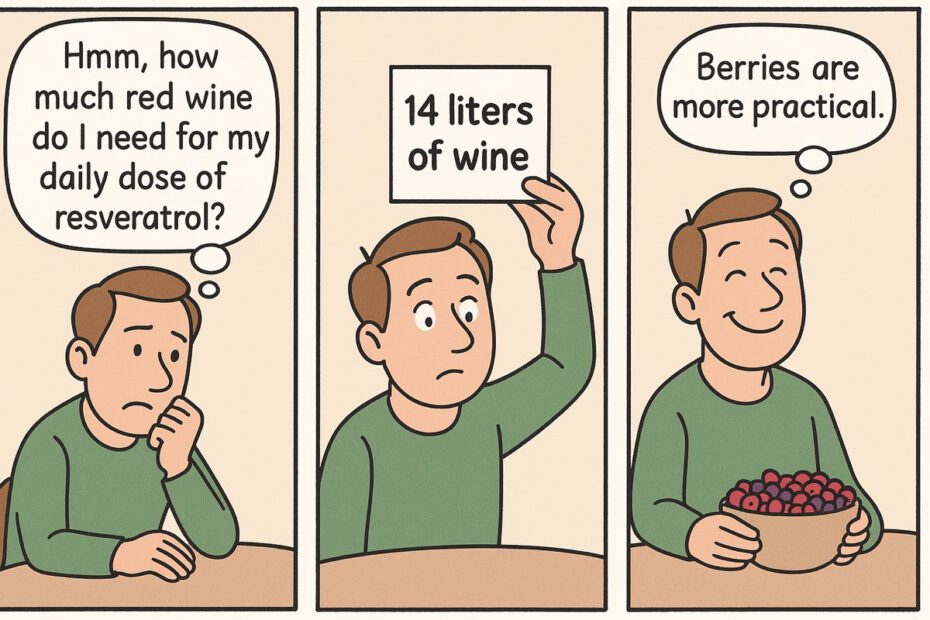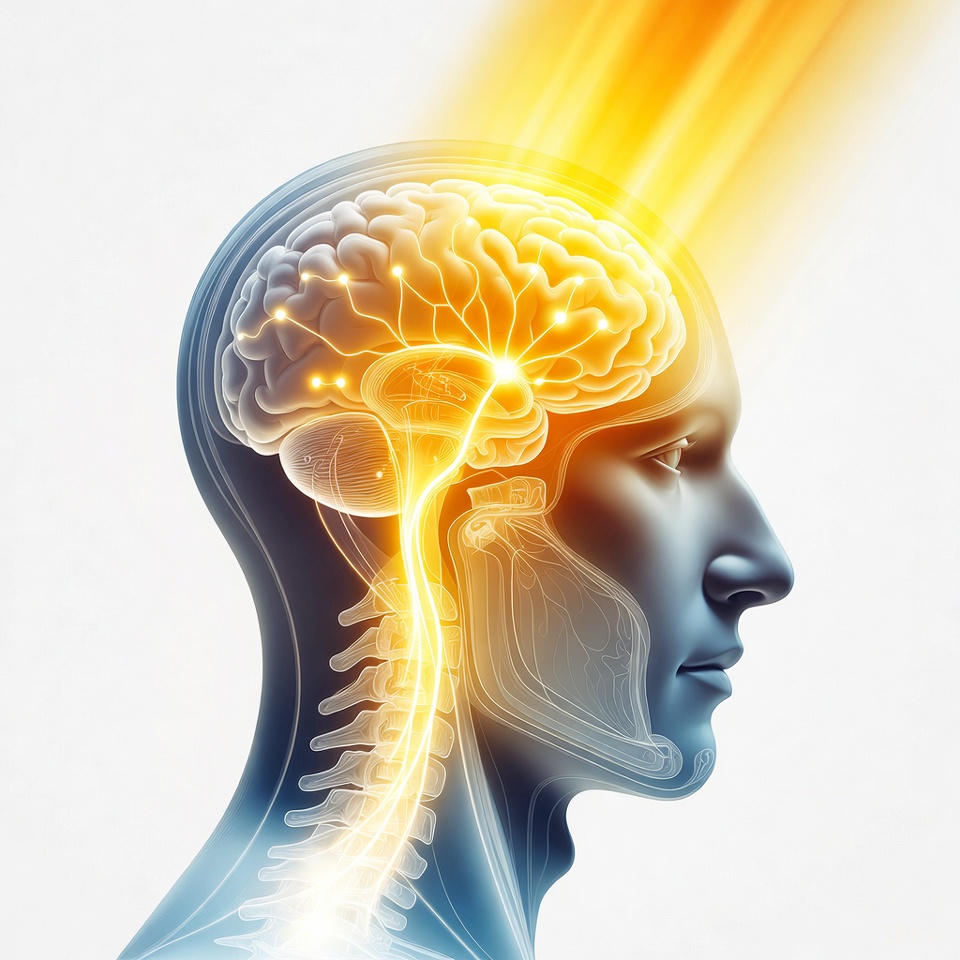Bernd Guzek, MD, PhD
Introduction
“A glass of red wine a day protects the heart.” “Beer is healthy because of the vitamins”—you hear these claims all the time. For many, they serve as a convenient excuse: if you drink alcohol, at least do it with a clear conscience. But science has long shown: that’s a myth. The beverage industry still subtly amplifies these ideas by cherry-picking studies and promoting positive headlines.
In this article, we take a closer look: What is alcohol, really? What’s behind the claim it could be healthy? And what are the actual health effects—even at low doses?
What is alcohol?
Ethanol—the alcohol in drinks—is a neurotoxin and a carcinogen. It is produced when yeast ferments sugar. For yeast, that’s an advantage: alcohol suppresses competing microbes—something we also make use of in disinfectants, many of which are alcohol-based. Humans tolerate ethanol better—apparently. But at sufficiently high doses ethanol is lethal, and well below that it causes lasting harm.
Particularly problematic: its addiction potential. Alcohol acts directly on the brain’s reward system, promotes tolerance and dependence. That’s one reason it’s deeply embedded in our culture—and at the same time one of the largest avoidable sources of disease burden worldwide.
So… is alcohol “healthy” in small amounts?
Biased studies
News stories often claim “moderate drinking prolongs life.” These headlines usually stem from cohort studies—large groups followed over years. Sounds solid, but there’s a catch: the result stands and falls with who you compare to.
Researchers always need a comparison group (“reference group”). Only by comparing wine or beer drinkers to a fitting control group can we say anything about mortality risk. And this is where key distortions creep in.
A team led by Stockwell analyzed more than 100 such studies in 2024 [1]. Their finding: apparent benefits vanish once biases are corrected. Typical issues include:
- “Former drinkers” lumped in with abstainers. People who quit for health reasons (heart attack, cancer, liver disease…) are counted as “non-drinkers”. They are already sicker than average. Compared to them, moderate drinkers look healthier—even though the difference is caused by bad grouping. In several large U.S. cohorts (e.g., NHANES), the “abstainer” group contained over one-third former drinkers who had stopped because of existing illness. Naturally, their mortality was higher—not because they didn’t drink, but because they were already unwell. When you remove these “ex-drinkers” and compare lifelong abstainers to moderate drinkers, the supposed survival benefit disappears [1].
- Occasional or very light drinkers counted as “abstainers”. Someone who has a single drink per month lives differently from someone who never drinks. Mixing them blurs differences and makes drinkers look better.
- Too short follow-up or mismatched age groups. Many alcohol-related diseases show up after 50 or 60. Short studies undercount events and underestimate harm. In the Canadian National Population Health Survey, moderate drinkers initially seemed to fare best; restricting analysis to the 60+ group and extending follow-up flipped the picture to a linear risk increase with intake—no benefit [2].
Bottom line: if comparison groups aren’t cleanly defined, moderate drinking can appear “healthy”. In reality, the abstainer group is often made artificially sicker, or harms haven’t surfaced yet. Other large analyses reach the same conclusion: no survival benefit from moderate drinking [2].
Media myths
So why does the “alcohol is healthy” idea persist? Hard to say. It’s striking that institutes promoting new “health benefits” of alcoholic drinks often sit in wine-growing regions. Coincidence or not? We can’t say—but here are a few common examples:
- “Wine protects the heart—thanks to resveratrol.” Resveratrol is a plant compound in red grape skins. In animals it shows antioxidant and anti-inflammatory effects. Sounds great—except typical effective human trial doses are 100–500 mg/day while a glass of red wine has about 0.3 mg. You’d need hundreds of liters per day to get near study doses [3].
- “Beer is a vitamin source.” Beer contains some folate and small amounts of B-vitamins. But alcohol simultaneously impairs the handling of B1 and folate—heavy drinkers often develop pronounced deficiencies. Net effect: negative; alcohol metabolism can consume more than beer supplies [4].
- “Hops fight cancer—xanthohumol in beer.” Xanthohumol is indeed interesting in the lab. But beer contains only trace amounts—typically 0.01 mg per liter—while human studies use about 24 mg/day. That’s dozens to hundreds of liters daily—absurd [5].
Overview: so-called “beneficial” compounds in wine and beer
| Compound | Claimed effect | Amount in drink | Effective dose | Better source |
|---|---|---|---|---|
| Resveratrol (wine) | Antioxidant, vascular support | ~0.3 mg/glass | 100–500 mg/day | Grapes, berries, peanuts |
| Xanthohumol (beer) | Anticarcinogenic (preclinical) | ~0.01–0.1 mg/L | ~24 mg/day | Hops extracts |
| Folate (beer) | B-vitamin | ~20–100 µg/0.5 L | 400 µg/day | Vegetables, legumes, whole grains |
| Polyphenols | Antioxidant | present, but low | no fixed dose | Fruit, vegetables, tea |
Note: Thinking two liters of beer a day would “cover folate” misses the point—alcohol metabolism consumes folate and other B-vitamins, leaving a net deficit.
Which health problems does alcohol promote?
That was the mildly entertaining part. Now, which diseases does alcohol actually promote?
- Cancer: Alcohol is a recognized carcinogen. It raises the risk of cancers of the oral cavity, pharynx, esophagus, liver, and colon—and especially breast cancer. Even one drink a day measurably increases breast cancer risk in women [6].
- Blood pressure & heart: Risk rises almost linearly with intake—no safe threshold. Arrhythmias like atrial fibrillation also become more frequent [7].
- Liver: Fatty liver, hepatitis, cirrhosis—even sustained “moderate” intake can damage the liver.
- Brain & nerves: Alcohol damages neurons, impairs vitamin uptake (notably B1), and can cause lasting cognitive deficits.
- Sexual health: In men, chronic intake clearly increases erectile dysfunction risk—through hormonal changes, neuropathy, and endothelial damage. In women, recent meta-analyses show a ~74% higher risk of sexual dysfunction among drinkers vs. non-drinkers [8].
Key facts at a glance
| Topic | Key point |
|---|---|
| Mortality | No life-extension from “moderate” drinking once biases are corrected (JAMA Netw Open 2023; Stockwell et al. 2024). |
| No safe level | WHO: “No level of alcohol consumption is safe for our health.” Risk starts with the first sip. |
| Resveratrol | Effective ~500 mg/day—one glass of wine provides ~0.3 mg. Any benefit ≠ ethanol. |
| “Beer vitamins” | Folate measurable but too low; alcohol impairs B-vitamin status. Net negative. |
| Cardio | Hypertension & AF risk rises without a threshold; abstinence lowers AF recurrences. |
| Sexual function | Strong evidence of harm with heavy/chronic intake; mixed at “moderate” in men; ~+74% dysfunction risk in women. |
Final thought
“A little drink is healthy,” they say—convenient, but false. Yes, wine and beer contain plant compounds that look promising in the lab. But the amounts in drinks are tiny: practically negligible. To reach effective doses, you’d be talking about tens to hundreds of liters per day—neither realistic nor sensible.
As ever, the dose makes the poison—and in wine/beer the dose of “good stuff” is so low that you’d need hundreds to thousands of liters to match study doses. Better sources: berries, grape juice, tea, vegetables—or targeted supplementation.
If you actually want to help your health, choose berries over red wine, tea over beer, and alcohol-free alternatives. You’ll get the helpful plant compounds—without the risks.
| Topic | Takeaway |
|---|---|
| Resveratrol (wine) | ~0.3 mg per glass → study dose ~500 mg ≈ ~263 L wine needed. |
| Xanthohumol (beer) | Typically 0.01 mg/L → 24 mg = ~2400 L beer. |
| Folate (beer) | 4–8 L could cover daily needs on paper—but alcohol impairs utilization. Net negative. |
| Polyphenols in general | Present, but far less than in berries, fruit, veg, or tea. |
FAQ
Is a glass of wine a day really healthy?
No. The supposed benefit usually comes from biased comparisons—for example, former drinkers (often already ill) are grouped with lifelong abstainers. Clean up the bias and the “benefit” disappears. The WHO is clear: there is no safe level of alcohol use.
Don’t wine or beer contain valuable compounds like resveratrol or vitamins?
They do—but in tiny amounts. A glass of wine has ~0.3 mg resveratrol while studies use ~500 mg/day. For xanthohumol in beer you’d need thousands of liters to reach study doses. Vitamins are partly counteracted by alcohol. Better sources are berries, grapes, vegetables, or tea.
Which illnesses can even small amounts of alcohol promote?
Alcohol raises the risk of cancer (e.g., breast cancer at ~1 drink/day), hypertension and arrhythmias, damages the liver, and can impair sexual function. Effects are measurable even at low doses—so: the less, the better.
More in the books “Alkohol adé” or “Die Suchtlüge”.
Latest posts on our blog
- Bill Wilson, Founder of Alcoholics Anonymous, and His Vitamin Therapy for Alcoholism
- Alcoholic Cardiomyopathy – When Alcohol Attacks the Heart Muscle
- Could Vitamin D Be the Key to Beating Addiction?
- Alcohol is no vitamin source – and never healthy
- Psychiatric effects of nutritional deficiencies in alcoholism
- Alcohol to blame for more than 700,000 cancers annually
- England: Alcohol kills 20 percent more people during Corona
- Vitamin B1 against heart damage caused by alcohol
- Female lawyers drink more often than their male colleagues
- Flying and alcohol – mixed messages from the airlines

Dr. med. Bernd Guzek, MD
Physician, author, family member of person in recovery from alcohol use disorder & co-founder of Bye, Bye, Booze
Has worked for many years on the biochemistry of addiction and brain metabolism disorders and on how nutrients can influence them.
- Stockwell T, et al. Why Do Only Some Cohort Studies Find Health Benefits from Low-Volume Drinking? Journal of Studies on Alcohol and Drugs. 2024.
- Zhao J, et al. Association Between Daily Alcohol Intake and Risk of All-Cause Mortality. JAMA Network Open. 2023.
- Lamuela-Raventós RM. Resveratrol: origin, metabolism, and impact on health. Crit Rev Food Sci Nutr. 2017.
- Netdoktor.at / DGE / NIAAA – Informationen zu B-Vitaminen & Alkoholstoffwechsel.
- Stevens JF, Page JE. Xanthohumol and related prenylflavonoids from hops and beer: to your good health? Phytochemistry. 2004.
- WHO, WCRF, NCI Cancer Fact Sheet: Alkohol und Krebs.
- Roerecke M, et al. Alcohol consumption and risk of hypertension/atrial fibrillation. Meta-Analysen 2023–2024.
- Peng Y, et al. Alcohol consumption and female sexual dysfunction: a meta-analysis. 2023; sowie aktuelle Reviews zu ED bei Männern.
- WHO Europe. No level of alcohol consumption is safe for our health. 2023.



